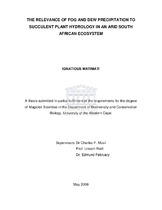| dc.description.abstract | Fog and dew interception and utilization by plant canopies remains one of the least
considered aspects of vegetation studies at any scale yet the few studies that have been conducted point to their considerable influence on ecological processes and a critical role in modulating climate in southern African arid ecosystems. Their relevance to succulent plant hydrology was investigated in this study.The first study measured stable 18O and 2H isotope ratios in samples of rain, fog and dew water and compared these with those assayed monthly in stem xylem water of six
succulent shrub species over a one year period. Negative 18O and 2H ratios were observed in the stem xylem water of all six species signifying a predominance of water derived from fog and dew precipitation which was most conspicuous during the wet winter. This implied that fog and dew are even more important sources of water than rain and corroborated by significant correspondence found between fog and dew frequencies, succulent foliar water
contents and quantum yields of photochemistry.The second study monitored variations in stem diameter at 2-hourly intervals in 8 succulent shrub species of diverse growth form over a 9-month period. Two groups of species were distinguished based on whether their daily amplitudes in stem diameter were
consistently positively correlated with daily fluxes in vapour pressure deficit, which were indicative of a persistent CAM photosynthetic mode, or intermittently correlated with daily fluxes in vapour pressure deficit, which were indicative of mixed CAM and C3 photosynthetic modes. Among species displaying a persistent CAM photosynthetic mode, high nocturnal fog and dew precipitation amounts corresponded with low daily amplitudes in stem diameter, and vice versa, which pointed to reduced nocturnal stomatal water loss. These patterns, which were indistinct among species displaying mixed CAM and C3 photosynthetic modes, were
corroborated by small daily amplitudes in stem diameter also consistently observed in one species displaying a CAM photosynthetic mode in ambient than artificially fog and dew excluded environments.The third study monitored changes in water mass at hourly intervals of quartz gravel substrates with different dwarf succulent species assemblages over an 8-month period.Consistently greater net amounts of water were intercepted daily by quartz gravel substrates containing Agyroderma pearsonii than Cephalophylum spissum plants as well as those without plants. These attributed to a high water repellence of A. pearsonii leaves and less
radiation absorbed by the paler silvery to grey-green leaves of A. pearsonii leaves than the dark green leaves of C. spissum resulting in lower leaf temperatures and less water loss by transpiration. Quartz gravel soils devoid of plants intercepted nearly 5-times greater amounts of precipitation contributed by fog and dew than that contributed by rain. These precipitation amounts exceeding the high percentages of total hydrological input contributed by fog and dew reported in other ecosystems.The study concludes that fog and dew are a vital source of water for succulent shrubs in arid South African ecosystems and imply that diminished fog and dew frequencies associated with elevated night time temperatures accompanying global warming could exacerbate plant drought stress. | en_US |

